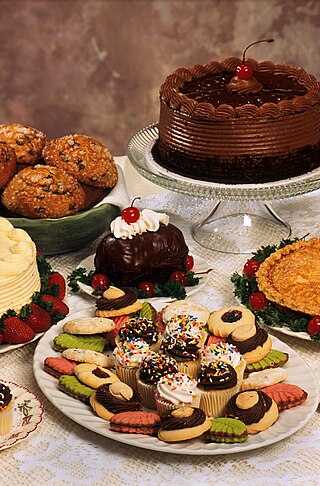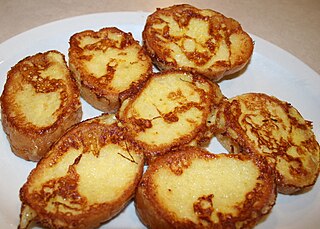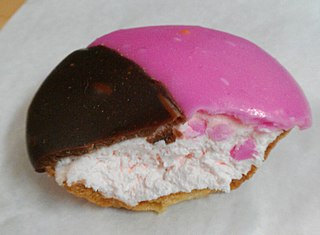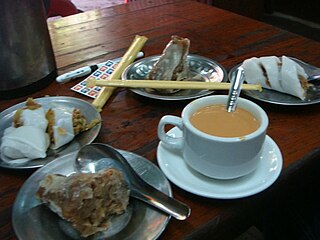
Dessert is a course that concludes a meal. The course consists of sweet foods, such as cake, biscuit, ice cream and possibly a beverage such as dessert wine and liqueur. Some cultures sweeten foods that are more commonly savory to create desserts. In some parts of the world, there is no tradition of a dessert course to conclude a meal.

French toast is a dish of sliced bread soaked in beaten eggs and often milk or cream, then pan-fried. Alternative names and variants include eggy bread, Bombay toast, gypsy toast, and poor knights (of Windsor).

Condensed milk is cow's milk from which water has been removed. It is most often found with sugar added, in the form of sweetened condensed milk, to the extent that the terms "condensed milk" and "sweetened condensed milk" are often used interchangeably today. Sweetened condensed milk is a very thick, sweet product, which when canned can last for years without refrigeration if not opened. The product is used in numerous dessert dishes in many countries.

Teh tarik is a popular hot milk tea beverage most commonly found in restaurants, outdoor stalls, mamaks and kopitiams within the Southeast Asian countries of Brunei, Malaysia, Indonesia, Singapore, and Thailand. Its name is derived from the process of repeatedly pouring the drink back and forth from one container into another with arms extended during preparation, which helps to slightly cool the tea for consumption and giving it a frothy head. It is made from a strong brew of black tea blended with condensed milk.

Melktert is a South African dessert originally created by the Dutch settlers in the "Cape" consisting of a sweet pastry crust containing a custard filling made from milk, flour, sugar and eggs. The ratio of milk to eggs is higher than in a traditional Portuguese custard tart, British custard tart or Chinese egg tart, resulting in a lighter texture and a stronger milk flavour.

A neenish tart is a tart made with a pastry base and a filling consisting of sweet gelatine-set cream, mock cream, icing sugar paste, or lemon and sweetened condensed milk mixture, with dried icing on the top of the tart in two colours. The addition of a layer of raspberry jam is a common recipe variation. The colours used for the icing are usually some combination of brown, white, and pink. They are almost exclusively sized as individual servings, 60–80 mm in diameter. The tart was originally created in Australia and is mainly found there, alongside New Zealand and the Falkland Islands.

Kue are bite-sized snacks or desserts originally from what is now Indonesia but have since spread throughout Southeast Asia. Kue is a fairly broad term in Indonesian to describe a wide variety of snacks including cakes, cookies, fritters, pies, scones, and patisserie. Kue are made from a variety of ingredients in various forms; some are steamed, fried or baked. They are popular snacks in Indonesia, which has the largest variety of kue. Because of the countries' historical colonial ties, Koeé (kue) is also popular in the Netherlands.

Sweet potato pie is a traditional dessert, originating in the Southern United States. It is often served during the American holiday season, especially at Thanksgiving and Christmas in place of pumpkin pie, which is more traditional in other regions of the United States.

Custard tarts or flan pâtissier/parisien are a baked pastry consisting of an outer pastry crust filled with egg custard.

Kheer or Meoa is a sweet from the Bengal region of the Indian subcontinent. It is not only a sweet by itself, but it is also used as the main ingredient of many other sweets. In North India, Kheer (Payesam) is a type of rice pudding. But in Bengal, in the same spelling and sound, Kheer is a completely different dish. It is very similar to the Khoa but with its own distinct flavor and texture. Kheer, a type of evaporated milk, is primarily made using cow or buffalo milk. The process involves boiling pure milk for an extended period, typically over an hour, to reduce it to one-third of its original volume. This concentrated form of milk is known as Kheer. Sometimes, ingredients like sugar, arrowroot, or Suji (semolina) are added during boiling to enhance sweetness and create a different flavor profile. However, the traditional version of Kheer, without these additions, is known for its authentic and distinct taste.

Egg pie is a sweet Filipino pie dessert with an egg custard filling and a characteristic toasty brown top made from egg whites. It is made with flour, sugar, milk, butter, and eggs. Calamansi juice or zest may also be added. It is a type of custard pie. Egg pies are commonly sold in bakeries in the Philippines.

Burmese milk tea is a tea beverage from Myanmar (Burma), traditionally made with strongly brewed black tea and milk. Burmese milk tea is commonly consumed at tea shops, as an accompaniment to bite-sized snacks like Burmese fritters and sweets called mont.












